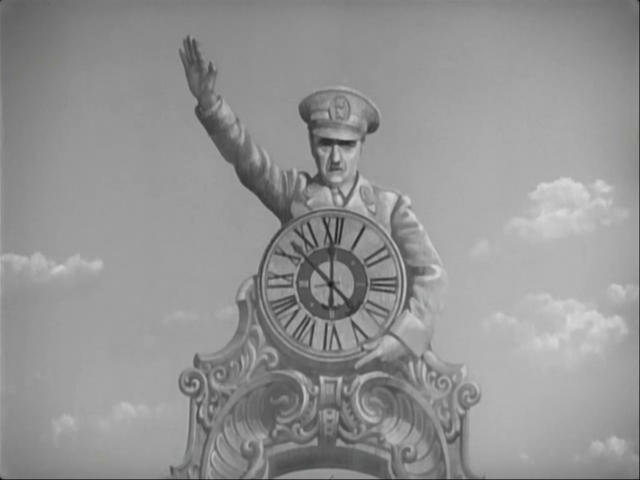
Title above is a headline that appears towards the end of THE MIRACLE OF MORGAN’S CREEK, which I always found obscurely hilarious. I presume Mussolini must have been awkwardly translated from time to time in the early forties, often enough for the gag to be comprehensible, but it’s still funny even if not comprehended.
Salute envy — Napaloni’s salute is bigger than Heinkel’s. And the massive clock — not easy to devise a monument more outlandish than any real dictators have built to themselves, but Chaplin manages it — is two minutes slow.

This brief section of the film is full of visual effects — the kind of thing which, CC complained, took a long time to prepare and necessitated the precise planning of the script.
As the dictators drive off, poor Mrs Napaloni gets separated from her husband and mixed in with the crowd.
Planning scene: Garbitsch outlines how Napaloni can be made to feel inferior, by psychology. This kind of set-up is new to Chaplin, and it’s made possible by dialogue. One could, I guess, find ways to do it in a silent, but it would be even more laborious. The idea is to set out clearly what the intention is, so we can enjoy everything going wrong. A boring scene in itself, but one that builds anticipation and gets paid off in laughs.


I once had a brief conference with the acting head of my institution, Edinburgh College of Art, in his office. I was a mere student. He had an incredibly low chair for me to sit in, my arse practically scraping the floor, while he sat erect behind his desk. I remember feeling not so much intimidated as contemptuous.
I’ve forgotten who was it who told the story about Harry Cohn’s office being modeled on Mussolini’s. And Cohn described how Mussolini, after dismissing him, had the door open on cue, with an electric button on his desk. “That son-of-a-bitch!” Then Cohn dismissed his interviewee, and as he reached the door, it automatically clicked open.
So, things go wrong — Napaloni comes in via the wrong door, surprising Heinkel with a back-slap that knocks him from his chair, banging his chin on the desktop. Napaloni, of course, is oblivious or indifferent to this mishap.
A reprise of the very good salute/handshake gag from the station, the two men’s hands shooting up then out, always missing one another.
Jack Oakie’s Chico Marx imitation even goes so far as to borrow his unique truncation of words: “Ah, my brother dictate!”

The low chair works momentarily — Benzino is discomfited. He simply cannot perform from such a low position. Has trouble even crossing his legs. Chaplin tracks in to savour the triumph.
Sitting on the desk, he reverses the situation, and on “They like to see new faces, he not only does the weird Mussolini lower lip thing, emulated by Trump, he turns right to the camera, as Chaplin had advised Oakie to do if he wanted to upstage the maestro.

The barbershop gag is good, but curiously mistimed — it starts fading out too soon for my taste, “stepping on the gag” to use Jerry Lewis’s phrase. I think the situation is good enough that they could have extended the action of the two idiots cranking themselves ever higher. Curious also that nothing is made of the connection to Chaplin’s other character, a barber. But I don’t know what he could have made of it.

Review of the army: Napaloni eating nuts from a paper bag (DUCK SOUP?), discarding the shells with blithe malice all over his pall “Hinky.” This scene works by not showing any of the tanks or aircraft under review, just the reactions and a few sound effects. Chaplin is really embracing sound cinema. In fact, its use of the unseen approaches the medium of radio. It’s not, admittedly, as great as his silent sequences — the best bits of this film are more visual. But it’s funny and odd.
Ballroom — as seen in Syd’s colour home movies. All the women are blonde. Another planning session with Garbitsch. The Chaplinverse’s version of the Anschluss is prepared, and it involves Henikel going duck hunting — the set-up for the film’s final comedy of errors.


Brief comic dance with Madam Napaloni. We see more of this in Syd’s home movies, and I wish we had more of it here — it plays better in longshot, even in Syd’s makeshift compositions. “Can you see my feet?” was Chaplin’s most common question to his cameramen, and here we don’t. It’s a loss.


Next up — Napaloni’s last stand! (It was over too soon.)



